For water damage restoration in East Point, GA, you’ll want to act swiftly at the first sign of trouble. Spot damp, peeling paint, or mold growth? It’s time to engage. Start with DIY extraction methods like using towels, mops, or wet/dry vacuums. Prompt response prevents structural damage and mold growth, saving you money and headaches. For severe cases, consider professional help. They possess high-grade equipment for effective water removal and continuous monitoring. Don’t forget the importance of cleaning, sanitizing, and proper home insulation to control humidity. Tackle this challenge confidently, there’s more wisdom just ahead for you.
Identifying Water Damage Signs
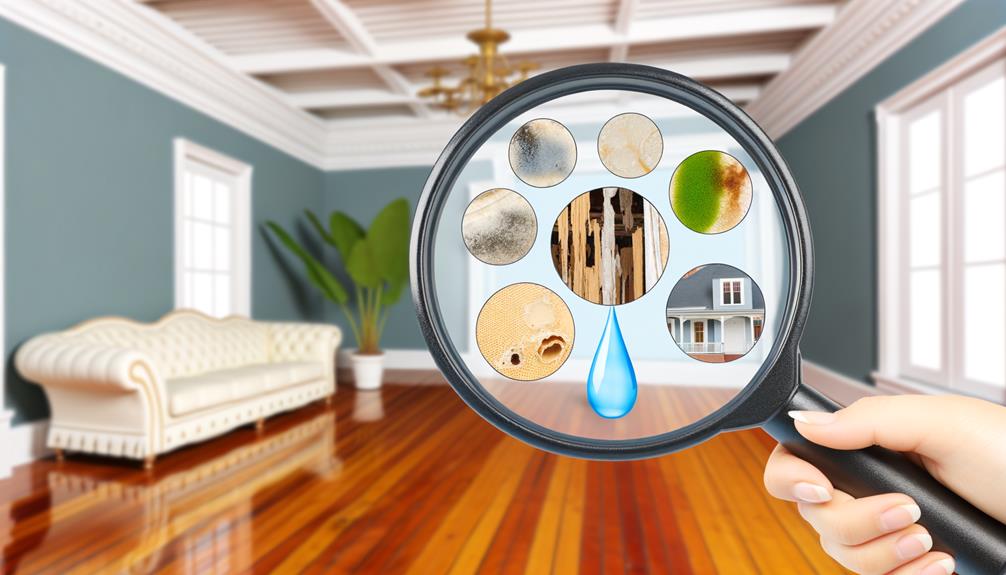
As a homeowner in East Point, GA, it’s important that you can recognize the signs of water damage to prevent further deterioration of your property. Hidden leaks may not be immediately visible, but they can cause extensive structural damage over time. You might notice unusual damp spots, peeling paint, or mold growth. These are red flags that you shouldn’t ignore as they signal potential hidden leaks.
To prevent structural damage, inspect your property regularly, especially after heavy rain or flooding. Look out for soft spots in your walls or ceilings; they indicate water intrusion. Be mindful of musty odors, too. Persistent dampness can lead to mold growth, which emits a distinct smell.
Also, keep an eye on your water bill. An unexpected increase could be a sign of hidden leaks. If you notice any of these signs, it’s critical to take action quickly. Reach out to a professional restoration company to mitigate the damage and protect your home’s structural integrity.
Understanding Water Damage Classes
It’s important for you, as a homeowner, to understand the different categories of water damage. These categories not just define the type of damage your home may have suffered but also influence the restoration process. Let’s investigate these categories, their characteristics, and how they can impact your restoration efforts.
Classifying Types of Damage
To safeguard your East Point home from further damage, you’ll need to understand the different classes of water damage. The accurate classification of damage is an indispensable part of the damage assessment and restoration process.
The four classes of water damage range from Class 1 to 4. Class 1 is the least harmful and involves only a small area with low absorption in materials. It’s the quickest and easiest to restore. Class 2 damage involves an entire room, with carpeting and walls absorbing water. The restoration process for Class 2 is more involved and can take longer.
Class 3 water damage is the most severe and includes water coming from overhead, saturating almost everything. This type of water damage requires professional assistance for restoration. Class 4 involves specialty drying situations, where certain materials like hardwood, plaster, or concrete have deep absorption of water and require more time to dry.
Understanding these classes helps you evaluate the severity of your home’s water damage. It will better prepare you for the next steps in the restoration process. Nonetheless, always remember to seek professional help for accurate damage assessment and effective restoration.
Impact of Water Classes
Knowing the impact of these water damage classes on your property can guide you in taking appropriate remedial measures. Each class represents different levels of water intrusion and potential damage. The severity ranges from Class 1, which is minimal and affects a small area, to Class 4, which can cause significant structural damage.
Your impact assessment should take into account the extent of water permeation, the type of materials affected, and the potential for mold growth. This will help you understand the potential risks to your home’s structural integrity and your personal safety.
Class 1 damage is usually manageable with basic drying and dehumidification techniques. Yet, Class 2 and 3 damages often require more intensive restoration techniques, including water extraction and the replacement of damaged materials. With Class 4 damage, it’s typically necessary to engage professional restoration services. They have the expertise to handle complex issues like deep saturation of structural elements.
Importance of Immediate Response
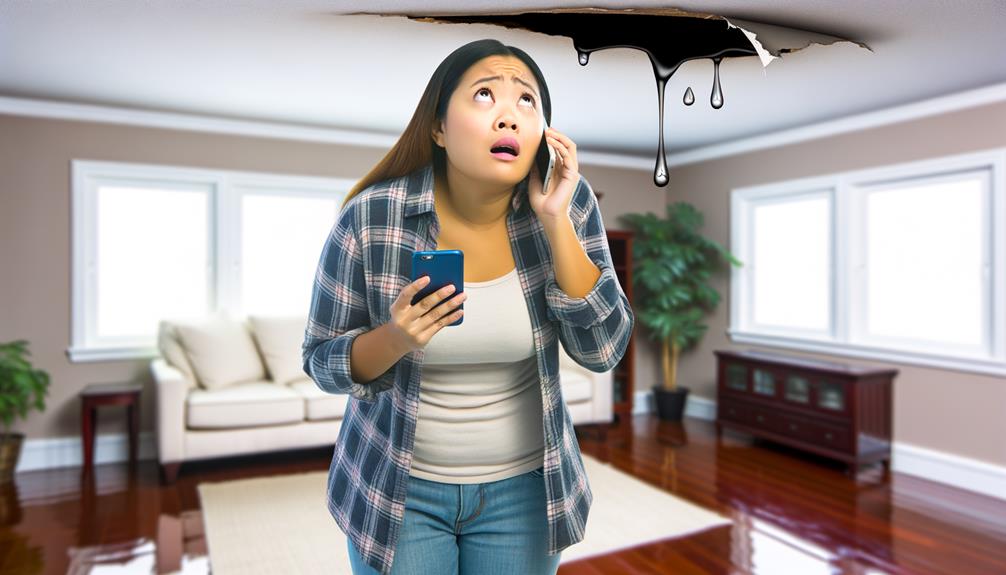
When dealing with water damage in your East Point home, it’s crucial to act promptly. Your immediate response can greatly influence the restoration process, with benefits ranging from saving valuable items to preventing further damage. Conversely, any delay could result in heightened risks and costs.
Understanding Urgency in Restoration
In the wake of a water damage incident, understanding the importance of immediate restoration isn’t just crucial—it’s a game-changer for preserving the integrity of your East Point, GA home. The urgency in restoration stems from the potential threats that water damage imposes on your property’s structure and your personal health.
An effective emergency response can vastly reduce your restoration timeline, minimizing the extent of the damage. When it comes to water damage, time isn’t on your side. The longer water remains, the worse the damage becomes, leading to costly repairs and potential health hazards.
To further highlight the importance of urgency in restoration, consider this simple table:
| Emergency Response | No Response | |
|---|---|---|
| Immediate | Minimizes damage | Damage escalates |
| After 24 Hours | Restoration underway | Mold growth begins |
| After 48 Hours | Damage controlled | Structural damage possible |
As you can see, an immediate response to water damage helps control the situation, while a lack of action can lead to escalating problems including mold growth and possible structural damage. Remember, when it comes to water damage restoration, every second counts.
Benefits of Rapid Action
Taking prompt action after a water damage incident can yield significant benefits for your East Point, GA home, from mitigating further damage to preventing health hazards. Timely intervention is not merely about salvaging material possessions; it’s about safeguarding your home’s structural integrity, preventing mold, and reducing costs associated with extensive repairs.
Firstly, preventing mold is one of the most critical benefits of rapid response. Mold thrives in damp conditions and can start growing within 24 to 48 hours of water exposure. It’s not just unsightly but also poses health risks including allergies and respiratory issues. Therefore, immediate action helps nip the problem in the bud, protecting your family’s health and your home’s aesthetics.
Secondly, by taking quick action, you’re reducing costs. How? Water damage worsens with time. The longer you wait, the more the damage spreads, and the higher the restoration costs. Acting promptly reduces the extent of damage, subsequently reducing repair costs.
Lastly, rapid response helps maintain your home’s structural integrity. Water can weaken building materials, causing structural damage. Immediate intervention stops further deterioration, preserving your home’s strength and stability. Remember, your home isn’t just a building; it’s your family’s safe haven. Protect it with prompt action.
Risks of Delayed Response
While understanding the benefits of a quick response is key, just as vital is recognizing the risks linked with delayed action after a water damage incident. Ignoring early detection signals can escalate your problem, leading to a stressful and costlier restoration process.
Here are the risks you face when you delay your response:
- Increased Restoration Cost: The longer you wait, the more extensive the damage becomes. This translates into a higher restoration cost.
- Structural Damage: Water can weaken your home’s structural integrity. Delayed response can lead to severe damage, making your home unsafe.
- Mold and Mildew Growth: Damp environments encourage mold growth, which can pose health risks.
- Risk to Personal Belongings: Your personal items may become irrevocably damaged if you don’t act promptly.
It’s vital that you conduct a risk assessment to understand the extent of the damage. Prevention methods like immediate response and regular maintenance can save you from the adverse effects of water damage. Remember, the faster you act, the less damage you’ll have to deal with, ensuring your home remains safe and secure.
DIY Water Extraction Methods
You’ll find several effective DIY water extraction methods that can help you mitigate the damage and clean up your East Point, GA home after it has suffered water damage. Remember that these methods are to be used for smaller incidents or as part of your initial emergency response before professional help arrives.
First, you can use buckets, towels, and mops to collect and remove water. It’s a manual method but helps in reducing the amount of standing water. Wet/dry vacuums can be used to extract water from carpets, floors, and furniture. Be sure to plug it into outlets that are far from water for your safety.
Moreover, using a dehumidifier can help remove excess moisture, prevent mold growth and maintain indoor air quality. Fans and heaters can also speed up the drying process. Remember to open windows and doors to improve ventilation.
Please note, your safety is paramount. Always turn off the electricity before starting any work, and wear protective gear like gloves and boots. If the damage is extensive, don’t hesitate to call for professional help. These DIY methods are just a stepping stone towards full restoration.
Professional Water Extraction Services
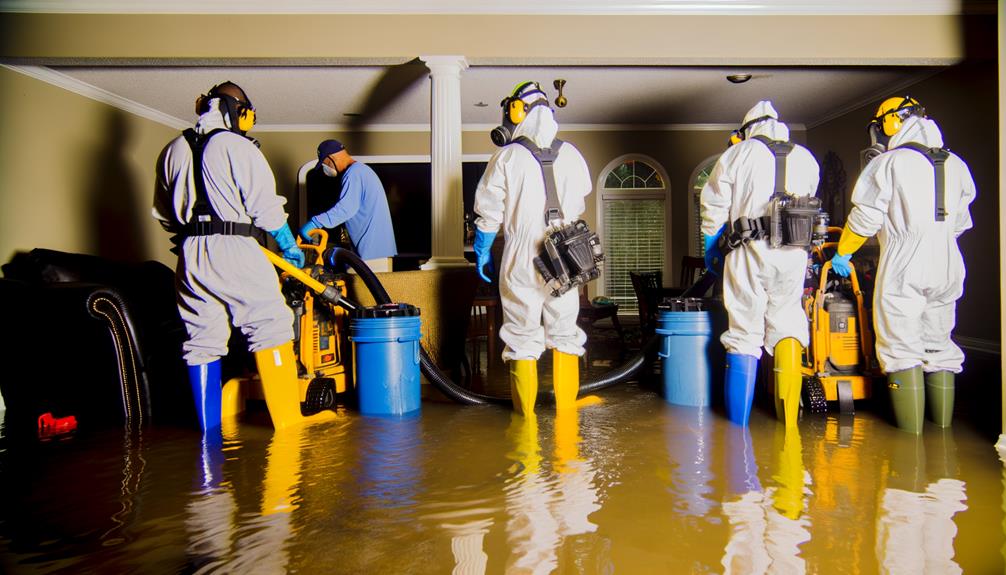
In the face of severe water damage, it’s crucial to enlist professional water extraction services to guarantee a thorough and safe cleanup. These experts provide a swift emergency response, making sure they mitigate further damage to your property.
Water removal is a critical step in this process. Professionals use advanced equipment to extract excess water, reducing the risk of mold growth and structural damage. Remember, it’s not just about getting the water out; it’s about doing it safely and efficiently.
Here’s what you can expect from professional water extraction services:
- Swift arrival at your property, minimizing the waiting time and potential damage.
- Effective water removal using professional-grade equipment, ensuring no excess moisture is left.
- Inspection and assessment of the water damage to determine the best course of action.
- Continuous monitoring of the drying process to make sure all water is extracted and potential mold growth is prevented.
Drying and Dehumidification Process
Once the water’s been extracted, it’s time to focus on the drying and dehumidification process, a necessary step to prevent secondary water damage like mold growth and warped wood. This step is all about air circulation and moisture control. To guarantee a fast and effective drying process, it’s vital to use high-velocity fans and dehumidifiers.
High-velocity fans promote air circulation, speeding up the evaporation process. They help disperse water vapors into the air, making it easier for dehumidifiers to suck in and remove the moisture. On the other hand, dehumidifiers work by pulling in damp, humid air and releasing dry, warm air back into the environment. They’re indispensable for maintaining moisture control, making the air less favorable for mold growth.
However, different materials dry at different rates. For instance, drywall and wood may take longer to dry compared to other materials. Hence, it’s important to monitor the moisture levels regularly using moisture meters until the readings are back to normal.
Cleaning and Sanitizing Affected Areas

After the drying and dehumidification process, it’s essential to thoroughly clean and sanitize the affected areas to eliminate any residual contaminants and reduce the risk of mold growth. It’s all about using the right sanitizing practices and disinfection techniques to guarantee the safety of your home.
There are a few steps you should follow when cleaning and sanitizing:
- Start by removing any visible dirt or debris. This will make the sanitizing process more effective.
- Use a high-quality disinfectant to sanitize hard surfaces. Make sure it’s formulated to kill a broad spectrum of microorganisms.
- For porous materials, such as carpets and upholstery, consider professional cleaning services. They have specialized equipment and knowledge to properly sanitize these items.
- Always wear personal protective equipment (PPE) during the cleaning process to shield yourself from potential hazards.
Mold Prevention After Water Damage
To safeguard your home against mold growth following water damage, it’s crucial to understand and implement specific preventative measures. Employing effective mold prevention strategies and ventilation tips can greatly reduce the chances of mold infestation.
Firstly, ensure sufficient ventilation in your home, especially in areas prone to moisture like bathrooms, kitchens, and basements. Proper air circulation helps in reducing moisture levels, a key factor for mold growth. Using dehumidifiers and fans can assist in maintaining an appropriate humidity level.
Secondly, regular inspection techniques can identify potential problem areas. Look out for signs of mold or excessive moisture, such as damp spots on walls or ceilings, and act promptly.
Moisture control is essential, so fix any leaks or seepages as soon as they’re detected. Here’s a quick reference table to guide your mold prevention efforts:
| Prevention Strategy | Implementation Tips |
|---|---|
| Ventilation | Use fans, open windows, install vents |
| Inspections | Regularly check for damp spots, visible mold |
| Moisture Control | Fix leaks, use dehumidifiers |
Dealing With Contaminated Water
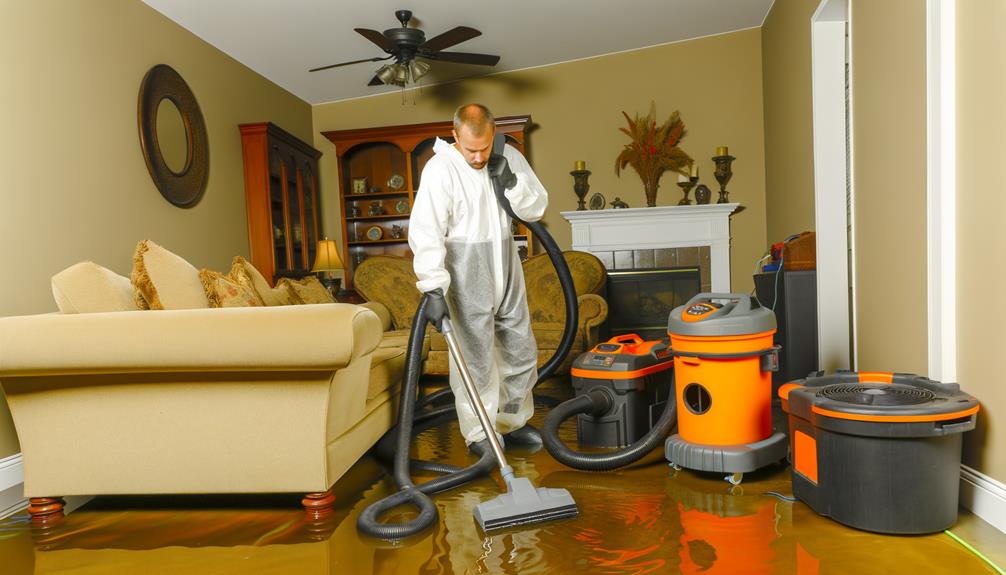
While safeguarding your home against mold is important, it’s also necessary to know how to handle contaminated water that often accompanies water damage. Contaminated water poses a serious health risk and if not managed correctly, can further worsen the damage to your property.
The first step is to identify and isolate contaminated materials. These may include carpets, drywall, and personal belongings that have been in contact with the water. Once identified, these items should be handled with care and removed from your home to prevent the spread of contamination.
Next, you’ll need to start the disinfecting process. This involves cleaning all affected areas with a strong, but safe disinfectant to kill any bacteria or harmful substances that may be present.
To make sure you’re fully prepared, here are some key points to remember when dealing with contaminated water:
- Always use protective gear, such as gloves and masks, when handling contaminated materials.
- Seek professional help if the level of contamination is high or widespread.
- Keep children and pets away from the affected areas until the disinfecting process is complete.
- Dispose of any food items that may have been exposed to the contaminated water.
Following these guidelines will help you manage a contamination situation effectively, ensuring the safety of your home and family.
Restoring Damaged Personal Items
When dealing with water damage, it’s not only about restoring your home but salvaging your personal items. You’ll need to know how to sort through these water-damaged items, apply effective cleaning methods, and preserve what keepsakes can be saved. Let’s investigate these steps to help you reclaim as much of your personal property as possible.
Sorting Water-Damaged Items
Sorting through your water-damaged items might seem like an overwhelming task, but understanding the restoration process can make it manageable and efficient. It’s crucial to prioritize salvaging valuables and documenting losses for insurance purposes.
Here are four key steps to help you sort and restore your water-damaged items:
- Identify and Separate Valuables: Precious items such as jewelry, artwork, or sentimental items should be identified and separated for professional restoration.
- Document Everything: Keep a detailed record of damaged items for insurance claims. Take photographs and note the condition and estimated value of each item.
- Prioritize Salvageable Items: Not all items can be salvaged. Prioritize items that are less damaged or have a higher value.
- Dispose of Unsalvageable Items: Anything that is heavily damaged or poses a health risk because of contamination should be disposed of safely.
Effective Cleaning Methods
Now, let’s examine some effective cleaning methods that can help restore your damaged personal items. It’s essential to utilize safe, deep cleaning techniques that guarantee both the longevity of your precious belongings and the environment’s wellbeing.
One of the best ways to start is by using eco-friendly solutions. These environmentally-friendly cleaning agents are not only gentle on your items but also pose minimal risk to both you and the environment. Using a soft brush, you can delicately scrub the damaged surfaces with these solutions, effectively removing dirt and grime without causing further harm.
For more stubborn stains and deeply ingrained dirt, consider utilizing specialized cleaning machines. Equipment like ultrasonic cleaners can offer a thorough, deep clean without the harsh effects of traditional cleaning methods. They operate by generating high-frequency sound waves that create tiny bubbles in a cleaning solution, which then burst and dislodge dirt particles.
Remember, always dry your items completely after cleaning to prevent mold growth. Employ air movers and dehumidifiers for efficient drying.
With these methods, you can confidently address the consequences of water damage. Restoring your belongings doesn’t have to be a nightmare; with the right techniques, you can ensure their safe and efficient clean-up.
Preserving Salvageable Keepsakes
Restoring your beloved treasures after water damage can appear like a daunting task, but with careful handling and appropriate techniques, it’s definitely possible to breathe new life into them. The process involves a combination of sentimental restoration techniques and practical measures to guarantee the longevity of your items.
Here are some valuable tips on how to proceed:
- First and foremost, document the damage. This involves taking photos and noting the extent of the water damage. Recording memories in this manner not only serves as a record for insurance purposes but also aids in the restoration process by providing a reference point.
- Promptly dry your keepsakes. Speed is crucial to prevent further damage. Air drying is often the best method, but always remember to handle your items gently.
- Clean your items meticulously. Use soft brushes and mild detergents to avoid causing more harm.
- Lastly, consider professional assistance. Experts in water damage restoration have specialized knowledge and equipment that can greatly enhance the outcome.
Insurance Claims for Water Damage
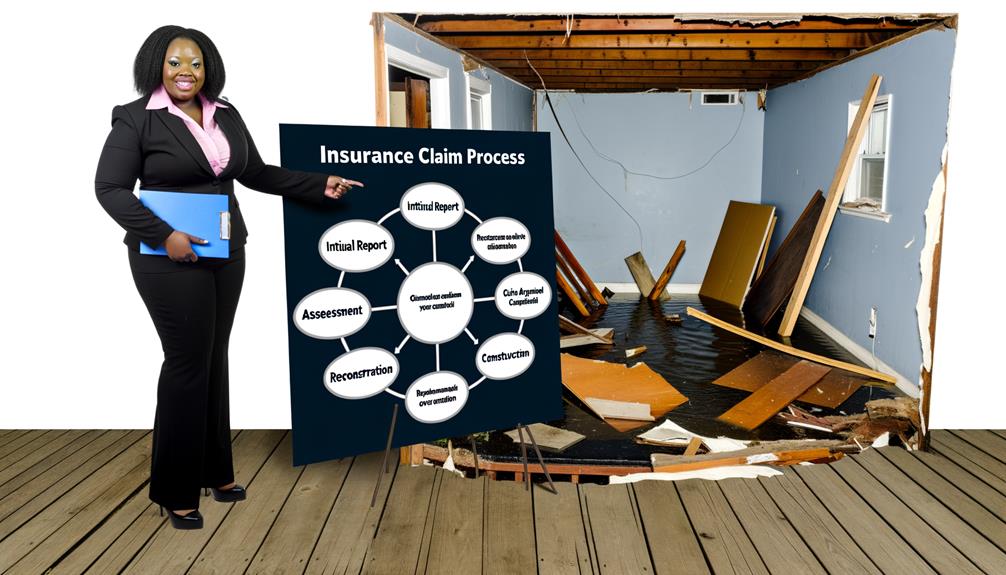
When you’re dealing with water damage in your East Point, GA home, it’s important to understand the complexities of filing an insurance claim to make sure you receive the compensation you deserve. The claim process can be intricate, and understanding the coverage details of your policy is essential.
Start by promptly notifying your insurance company about the damage. Take photographs or videos as evidence of the damage before any cleanup begins. It’s also wise to keep a list of damaged items along with their purchase price and date.
Your insurance agent will guide you through the claim process, but you should also read your policy to understand your coverage details. Some policies may cover the cost of water damage restoration, while others may not. Moreover, damage caused by natural floods often requires separate flood insurance.
Choosing a Restoration Company
After going through the insurance claim process, your next step is to select a reliable restoration company skilled in repairing water damage. Restoration company vetting is a vital part of this process. You’re not just looking for someone who can patch things up. You want a company that can restore your home to its pre-damage condition.
Consider these factors when choosing:
- Certification and Training: Ensure your chosen company is certified by recognized industry bodies and their team is well trained in water damage restoration.
- Experience: The company should have a proven track record in restoration work. The more experienced, the better.
- Availability: Water damage doesn’t work on a 9-5 schedule, and neither should your restoration company. They need to be available 24/7.
- Local References: Reputation assessment is crucial. Ask for local references and check online reviews.
The company you choose will be in your home, handling your belongings, so trust is paramount. Don’t rush this decision. Doing your research now could save you future headaches. Remember, your goal is to restore safety and normalcy to your home as quickly as possible.
Maintaining Your Home Post-Restoration
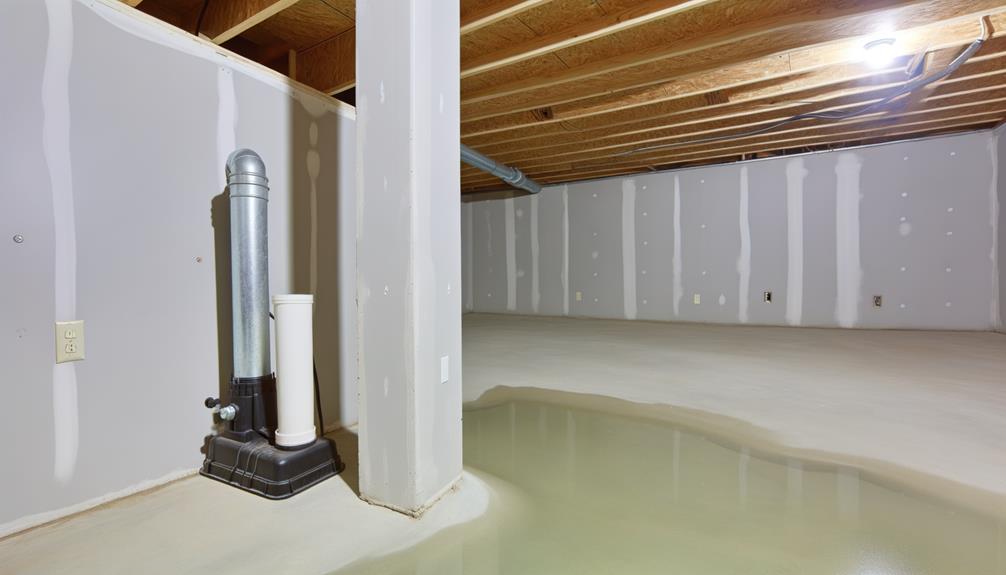
Now that your home’s water damage has been restored, it’s important to maintain its condition to prevent future issues. This involves establishing a routine for regular home inspections, managing your home’s humidity levels, and considering upgrades to your home infrastructure. Let’s investigate these necessary steps to help keep your East Point home safe and dry.
Regular Home Inspection Routine
To protect your East Point, GA home from future water damage, it’s essential to establish a regular home inspection routine post-restoration. This routine should encompass several key areas, including leak detection and foundation inspection, to guarantee the integrity and safety of your home.
Leak detection is crucial as leaks can cause significant water damage over time. Regularly inspect your home for signs of leaks, such as damp spots, mold, or unusual increases in your water bill. Don’t overlook hidden areas like under sinks and behind appliances.
Foundation inspection is equally essential. Look for large cracks or shifts in your home’s foundation, which can lead to water seeping into your home.
To further strengthen your inspection routine, consider these additional steps:
- Examine your roof: Damaged or missing shingles can allow water to penetrate your home.
- Inspect your gutters: Make sure they’re clean and drain properly to prevent water buildup and overflow.
- Monitor your landscaping: Verify that your yard slopes away from your home to prevent water pooling around your foundation.
- Regularly check appliances: Particularly those that use water, such as washing machines and dishwashers. Inspections can detect leaks and malfunctions early.
This thorough, regular inspection routine will help you prevent water damage and maintain the safety of your home.
Managing Humidity Levels
While safeguarding your East Point, GA home from water damage post-restoration, it’s critical you manage humidity levels effectively. High humidity can encourage the growth of mold and mildew, compromising your home’s structural integrity and your family’s health. To maintain a safe and comfortable environment, you should focus on moisture control and humidity management.
Invest in a quality dehumidifier, which can regulate and maintain ideal humidity levels. It’s recommended to keep indoor humidity below 60 percent during summer months, and between 25-40 percent during winter. You can monitor this using a hygrometer, a device that measures humidity levels.
Ensure proper ventilation in high-moisture areas like bathrooms and kitchens. Using exhaust fans can help reduce moisture accumulation. Regularly check and clean your HVAC system, as it can also assist in humidity regulation.
Lastly, consider moisture barriers in basements or crawl spaces, and regularly inspect your home for leaks or condensation. Addressing these issues promptly can prevent spikes in humidity.
Upgrading Home Infrastructure
After successfully restoring your home from water damage, it’s important to think about upgrading your infrastructure to further protect it from future incidents. Home upgrades, particularly in plumbing and waterproofing solutions, can provide a crucial line of defense against water damage.
Some upgrades may include:
- Plumbing Upgrades: Regularly inspect your plumbing system, and consider replacing old or rusty pipes. An upgrade to modern, more durable materials can significantly decrease the risk of leaks.
- Waterproofing Solutions: Implementing waterproofing solutions in areas prone to water damage, like basements and bathrooms, can create a safer, more resilient home.
- Roof and Gutter Maintenance: Proper roofing and gutter maintenance can prevent water from seeping into your home. Regularly clean your gutters and consider upgrading to a more durable roofing material.
- Home Insulation: Proper insulation can help control temperature and humidity levels in your home, reducing the potential for mold and mildew growth.
Water Damage Prevention Tips
You can protect your East Point home against potential water damage by following these preventive measures. Begin with waterproofing solutions. These could vary from sealants applied to your basement walls and floors, to more advanced systems that control water seepage.
Invest in regular leak detection. This involves checking your plumbing fixtures, pipes, and appliances for signs of leakage. Early detection can prevent significant water damage.
Drainage maintenance is vital. Regularly clean your gutters and downspouts to prevent blockages that may cause water to overflow and damage your property. Moreover, ensure your property slopes away from your home to encourage water to flow away from the foundation.
Lastly, don’t overlook foundation protection. Consider installing a French drain system to divert water from your foundation, or use a sump pump to remove excess water. Proper insulation and ventilation can also prevent condensation, which can lead to mold and mildew.
Conclusion
Remember, like a watchful lighthouse keeper, you’re your home’s first line of defense against water damage. Act quickly at first signs, leverage DIY methods, or call in professionals as needed. Don’t forget to file your insurance claims promptly, choose your restoration company wisely, and uphold regular maintenance post-restoration. By following these tips, you’re not just restoring your home, you’re safeguarding your personal haven. After all, prevention is always better than cure.
